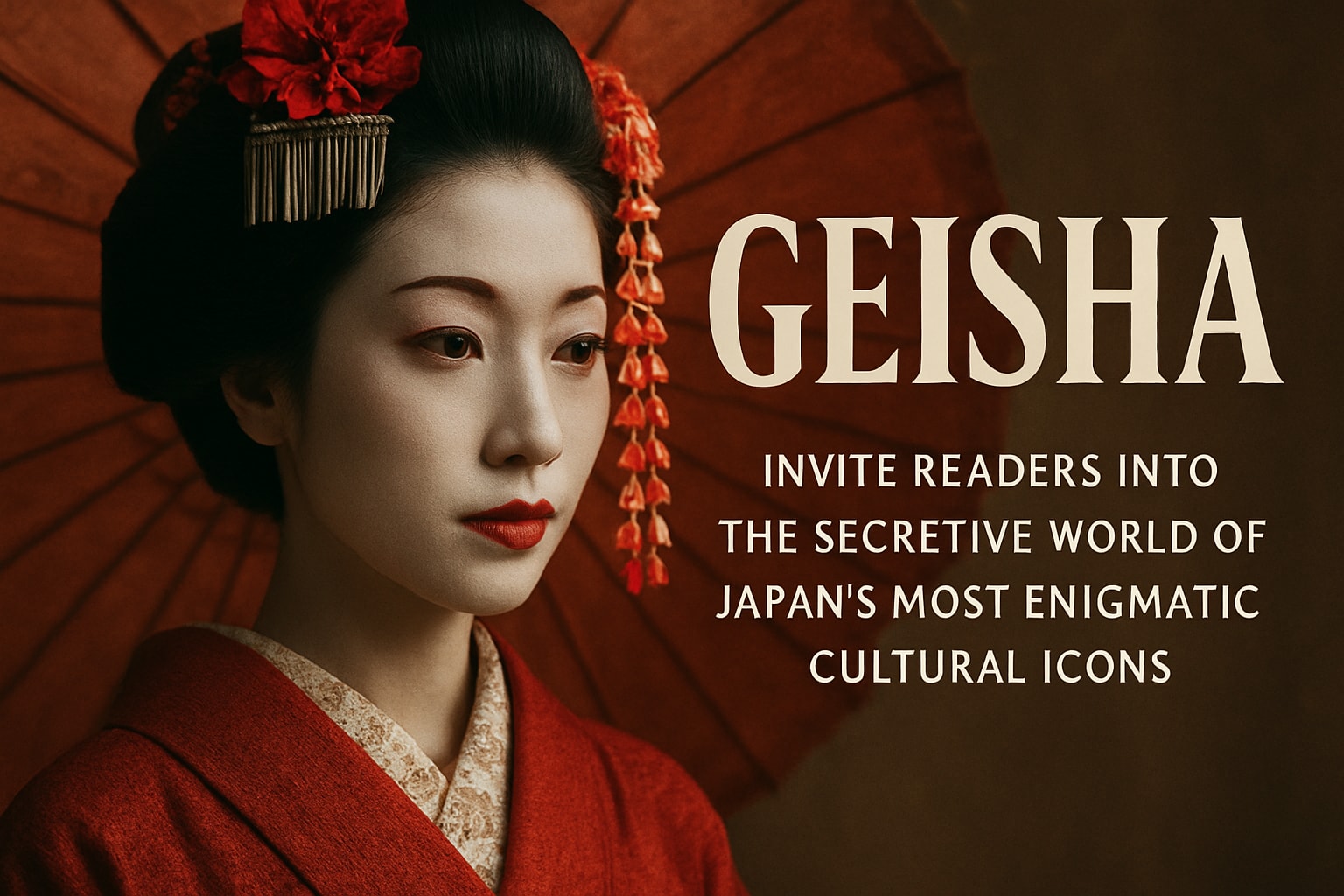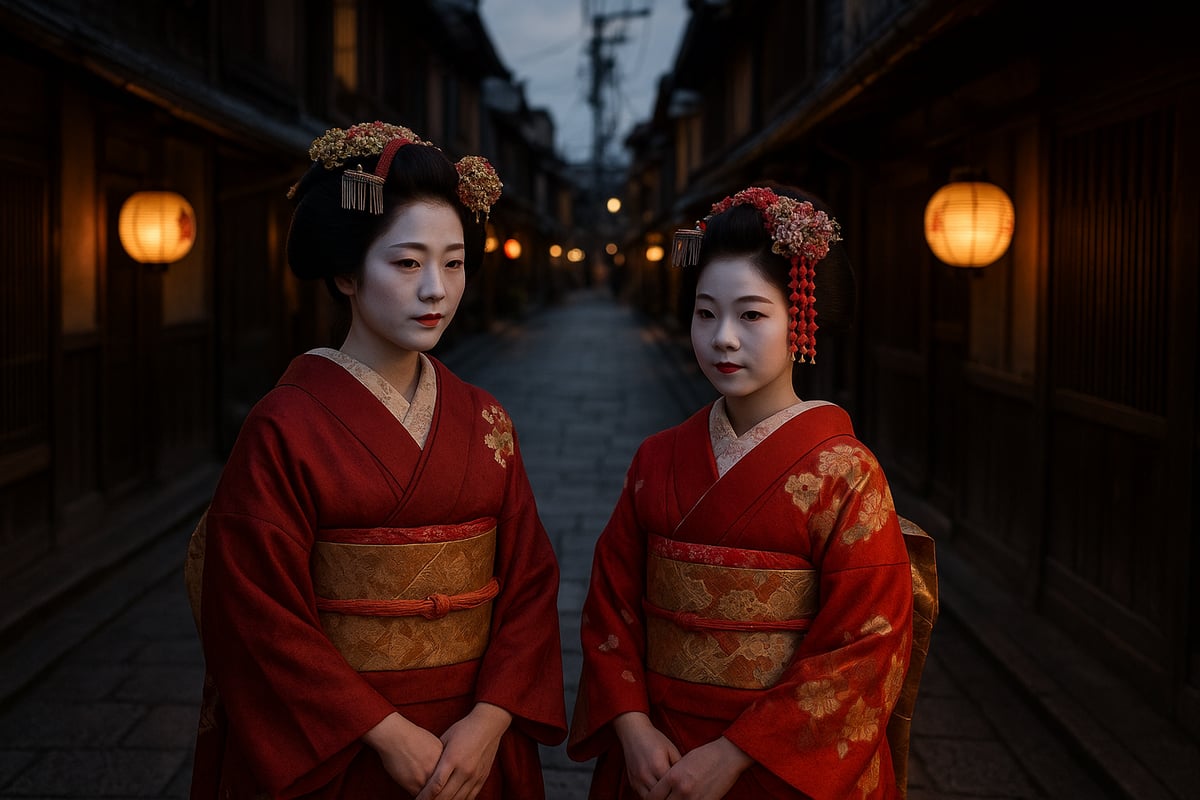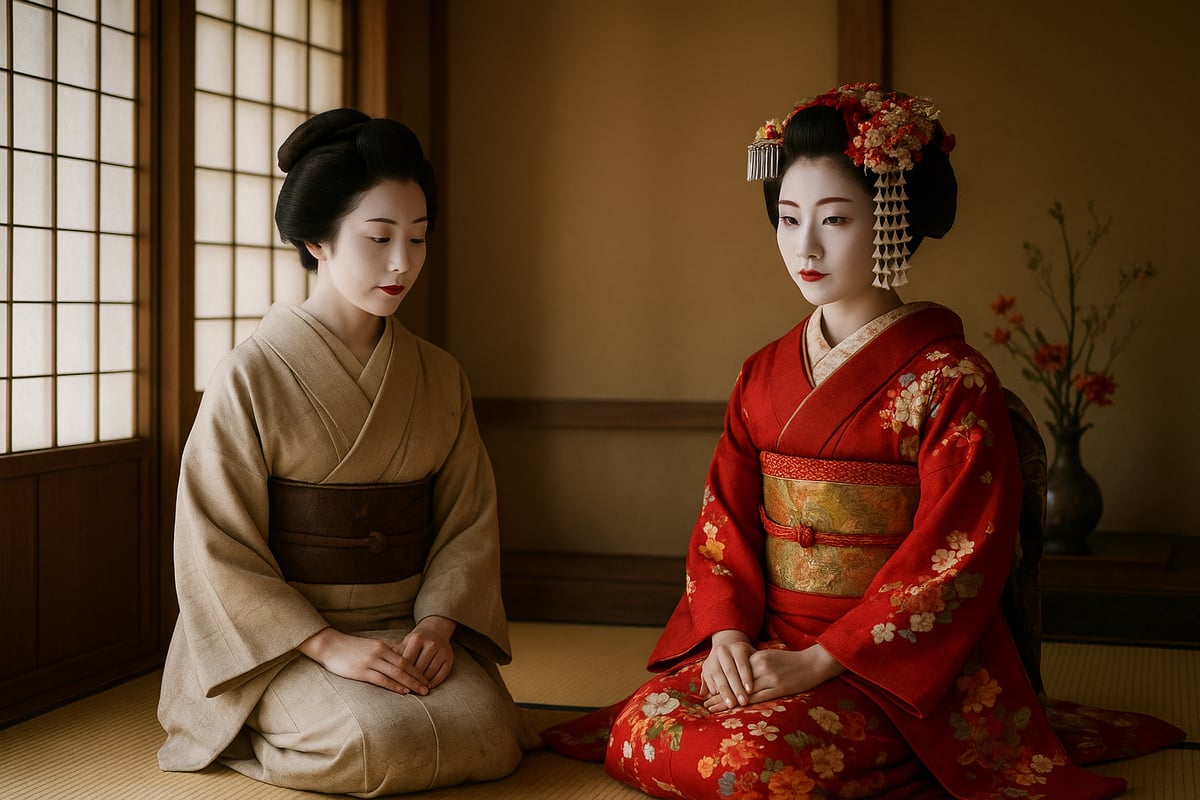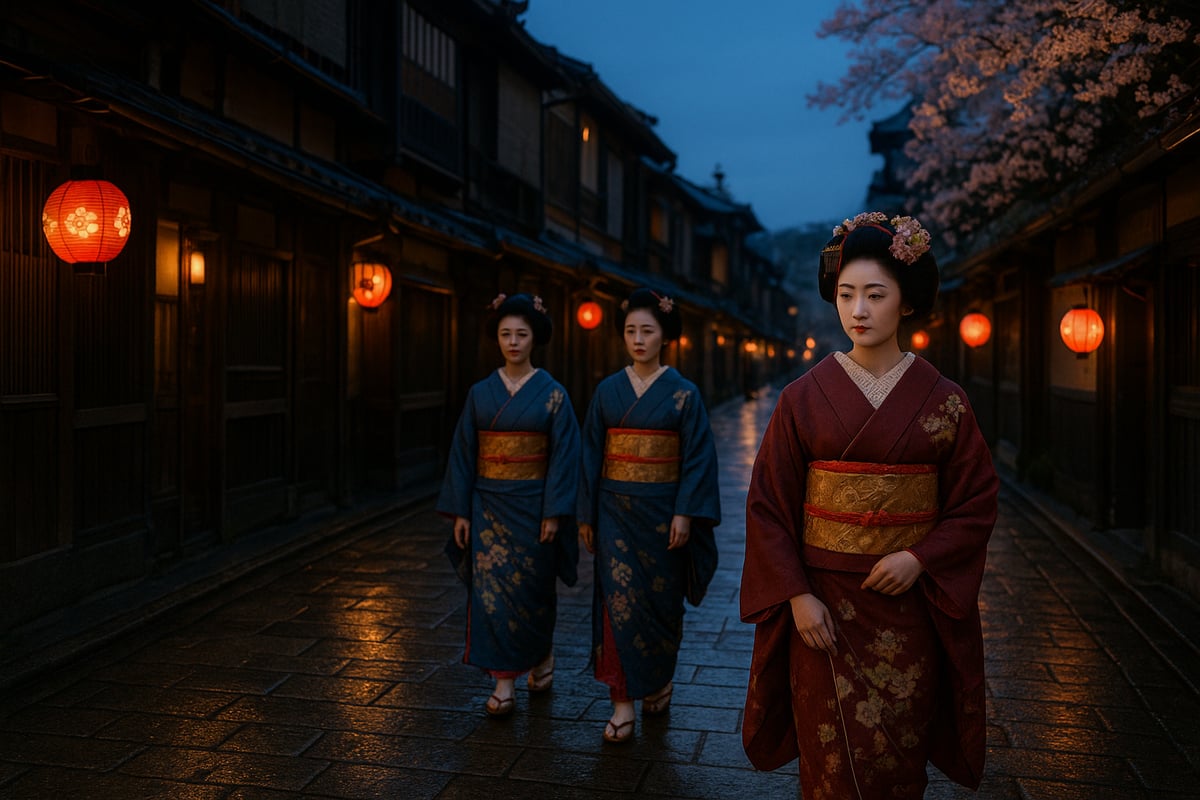LINE ID japanroyalservice
+817013781777 click here
+817013781777 click here
LINE ID japanroyalservice
+817013781777 click here
+817013781777 click here

Step into the enchanting world of geisha, guardians of Japan’s most captivating secrets. In this article, we reveal seven fascinating traditions that define these cultural icons and continue to inspire awe in 2025.
Discover how the allure and artistry of geisha have endured for centuries, even as their role evolves in modern Japan. From intricate rituals and elegant attire to rigorous training and refined etiquette, these customs remain as relevant and mesmerizing as ever.
Ready to experience authentic Japan? Let’s uncover the rituals and stories that make geisha an enduring symbol of beauty, talent, and tradition.
Japan’s geisha are more than just cultural icons; they are living embodiments of centuries-old artistry and tradition. The legacy of geisha weaves through the country’s history, shaping perceptions of elegance, hospitality, and refined entertainment that still resonate in 2025.

The origins of geisha trace back to the 18th century when they were initially male performers known as taikomochi or hōkan. Over time, women became the dominant figures, redefining the profession with an emphasis on artistic mastery rather than sensuality. Unlike the oiran courtesans, whose roles centered on beauty and allure, the geisha focused on music, dance, and conversation, elevating the art of hospitality.
By the 1920s, the geisha population soared to nearly 80,000. However, modernization and shifting societal norms led to a dramatic decline, with only about 1,000 to 2,000 active geisha in Japan today. Regional differences further distinguish their legacy: in Tokyo, they are called geisha, while Kyoto uses the term geiko and cities like Niigata and Kanazawa refer to them as geigi.
| Region | Term | Notable District |
|---|---|---|
| Tokyo | Geisha | Asakusa, Shinbashi |
| Kyoto | Geiko | Gion, Pontocho |
| Kanazawa | Geigi | Higashi Chaya |
The hanamachi, or "flower towns," served as cultural centers where geisha traditions thrived. These districts nurtured a unique blend of mentorship, artistry, and ritual, preserving customs that continue to define the profession.
In 2025, geisha remain vital guardians of Japanese heritage, balancing the preservation of tradition with the realities of a rapidly changing society. The meticulous rituals, from seasonal performances to daily training, are carefully maintained within hanamachi, ensuring that the essence of geisha culture endures.
Geisha symbolize omotenashi, the Japanese spirit of hospitality, and their skills are highly sought after by both locals and visitors. While tourism and media have brought increased attention, they have also introduced misconceptions and challenges. The exclusivity of ochaya, or teahouses, once reserved for select patrons, is gradually shifting. Today, opportunities for authentic encounters are expanding, especially in renowned districts like Gion in Kyoto and Asakusa in Tokyo. For those eager to explore these storied neighborhoods, Exploring Kyoto's geisha districts offers valuable insights into their history and ongoing traditions.
As Japan embraces the future, the geisha continue to inspire with their grace, artistry, and unwavering dedication to cultural excellence.
Step into the captivating world of geisha, where tradition and artistry intertwine, creating a cultural legacy that continues to enchant in 2025. The following seven traditions reveal how geisha maintain their mystique, skill, and relevance in modern Japan. As you read, discover the dedication, elegance, and adaptability that define these cultural icons.

The path to becoming a geisha is a demanding journey that begins in the teenage years. In Kyoto, aspiring geisha, called maiko or “dancing children,” usually start their training at 15 or 16. In Tokyo, the entry age is often 18. This apprenticeship is both rigorous and immersive, lasting several years.
Training focuses on mastering traditional Japanese arts:
Maiko reside in an okiya, or geisha house, where the okaasan, or "mother," oversees their daily life, finances, and training. Senior geisha act as mentors, guiding newcomers through the demanding routines and etiquette. The relationship fosters deep bonds of sisterhood and respect.
A pivotal moment is the erikae, or "turning of the collar" ceremony, marking the transition from maiko to fully-fledged geisha. Financial arrangements are intricate, with maiko incurring debts for training and attire, gradually repaid as their careers advance. In 2025, the tradition evolves, with some foreign women joining and modern training methods supplementing time-honored practices. The geisha apprenticeship remains a testament to dedication and resilience.
The visual identity of a geisha is unmistakable. Their iconic white oshiroi makeup, accented with bold red and black, is not just for show—it serves to highlight facial features in candle-lit teahouses. Special attention is given to the nape (eri-ashi), considered alluring in Japanese culture.
Maiko and geisha are distinguished by several aspects:
| Feature | Maiko | Geisha |
|---|---|---|
| Kimono Sleeves | Long, flowing (furisode) | Short, refined |
| Obi (belt) | Wide, elaborate | Narrower, understated |
| Footwear | Tall okobo clogs | Flat zori sandals |
| Kanzashi | Ornate, seasonal | Subtle, elegant |
| Makeup | More vibrant | Softer, minimalist |
Seasonal and rank-based changes influence kimono patterns, colors, and kanzashi hair ornaments. Preparation is a painstaking daily ritual, often requiring assistance. The symbolism behind every accessory and motif tells a story, reflecting nature, seasons, or status. In 2025, while some modern products are used, the essence of geisha aesthetics remains rooted in tradition and artistry.
A defining hallmark of geisha is their lifelong devotion to traditional Japanese arts. Every geisha is expected to excel in several core disciplines:
Daily practice is essential, with geisha often rehearsing for hours to perfect their craft. Public performances, such as Kyoto’s renowned Miyako Odori, showcase these skills and attract visitors from around the world. Innovation is embraced, as some geisha incorporate contemporary music or modern dance elements into their repertoire in 2025, ensuring their appeal remains fresh.
Despite modernization, fewer than 2,000 geisha are active today, underscoring the exclusivity and prestige of these traditions. For more recent statistics and insights, you can explore Geisha Research: Stats and Facts. Whether at Gion Corner or a private ozashiki banquet, witnessing geisha artistry is a rare privilege.
Geisha are renowned for their refined social skills and ability to create a welcoming, memorable atmosphere. At banquets, known as ozashiki, their role is to entertain guests with wit, charm, and subtlety.
Key elements of geisha entertainment include:
These games and rituals are not mere diversions, but showcase the geisha’s quick thinking and ability to read the room. The principle of omotenashi, or heartfelt hospitality, guides every gesture. Discretion is paramount; geisha are trusted confidantes, ensuring privacy for all guests.
In 2025, adaptations have been made for international visitors, with some geisha fluent in English or working alongside interpreters. Whether hosting Japanese businessmen or foreign tourists, the geisha’s etiquette continues to set the standard for hospitality.
Life inside the okiya is both communal and structured, forming the backbone of geisha society. The okaasan manages the house, overseeing finances, training schedules, and welfare of all residents.
Typical routines include:
Earnings are pooled, with deductions for living costs, training, and attire. Over time, geisha can achieve independence, but many retain close ties to their okiya, returning for major events or to mentor newcomers.
The okiya is more than a residence; it is a place of discipline, tradition, and enduring bonds. In Kyoto’s Gion district, for example, historic okiya continue to uphold these values, even as some modern geisha choose to live independently. The sense of sisterhood and shared purpose remains central to the geisha experience.
Geisha life is marked by a rhythm of seasonal changes and ceremonial milestones. Participation in festivals, such as Miyako Odori, Setsubun, and cherry blossom viewings, is integral to their role as cultural ambassadors.
Attire and adornments shift with the seasons:
Key ceremonies include the misedashi (maiko debut) and erikae (graduation to geisha), each accompanied by elaborate rituals and community gatherings. Symbolic gestures, like fan dances or tea ceremony rituals, reinforce the connection to tradition.
Geisha also engage in public performances, shrine visits, and parades, strengthening ties to their local communities. These traditions not only mark personal milestones but also preserve the cultural continuity of geisha for future generations.
Misconceptions about geisha abound, particularly regarding their role and profession. Contrary to stereotypes, geisha are not courtesans or sex workers. Historically, they have been distinct from oiran, with a focus on artistry and refined entertainment.
Legal and ethical codes strictly prohibit sexual services. The controversial mizuage ceremony, once a misunderstood rite of passage, was abolished in 1956. Media and literature have often blurred these distinctions, especially in the post-WWII era when the term "geisha girl" was misapplied.
Modern geisha associations are proactive in educating the public, both in Japan and abroad, about their true role. For a deeper dive into the topic, see Modern Geisha Misconceptions. Today, geisha stand as living symbols of Japanese culture, artistry, and hospitality, offering a window into authentic traditions while dispelling persistent myths.
Curious where to step into the living world of geisha in 2025? Japan’s iconic entertainers are not confined to history books—they continue to enchant guests in vibrant districts, offering a rare glimpse into a centuries-old tradition. Experiencing geisha culture firsthand is a highlight for travelers seeking authenticity and artistry.

The best places to witness geisha artistry are Japan’s historic hanamachi, or “flower towns.” Kyoto’s Gion district remains the most celebrated, while Tokyo’s Asakusa and Kanazawa’s Higashi Chaya offer equally atmospheric settings. Each district preserves its own unique customs and performances.
Visitors can attend public shows such as the Miyako Odori in Kyoto, enjoy seasonal festivals, or join guided tours that illuminate the world of geisha. For a deeper connection, private banquets at ochaya (teahouses) can be arranged, often with the help of local travel agencies. These exclusive experiences, while costly, provide unparalleled insight into the refined skills and etiquette of geisha.
Ethical travel is crucial. Always respect privacy, avoid photographing geisha without permission, and refrain from “geisha hunting.” Support preservation by choosing reputable experiences and learning the nuances that distinguish authentic geisha from impersonators. For those seeking comprehensive guidance, Traditional Japanese cultural experiences offer curated opportunities to engage with geisha traditions respectfully.
As tourism evolves, technology is making it easier for foreigners to access genuine geisha experiences, while safeguarding the integrity of these living cultural treasures. Thoughtful engagement ensures that the geisha legacy continues to inspire in the modern era.
As you’ve discovered, the world of geisha is a mesmerizing blend of tradition, artistry, and enduring elegance—one that invites deeper exploration beyond what you’ll find in any guidebook. If you feel inspired to witness these living traditions firsthand, why not take the next step toward an authentic Japanese journey crafted around your unique interests? With exclusive access to hidden teahouses, seasonal ceremonies, and expert local guidance, you can immerse yourself in the true spirit of Japan’s cultural heritage.
Request your private consultation: Design your bespoke Japan journey with our experts.